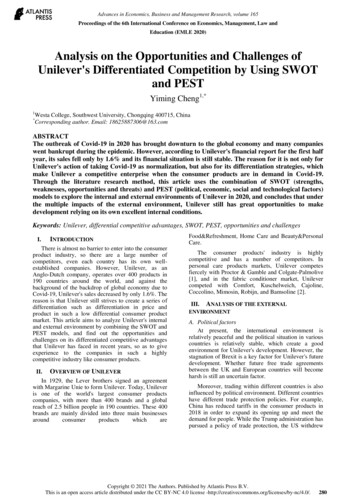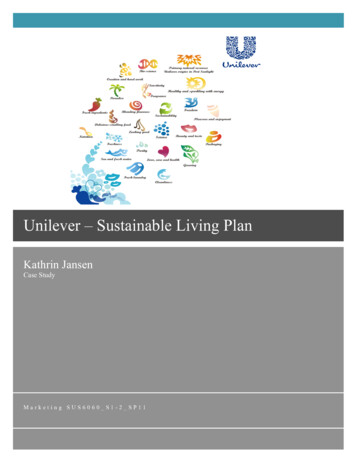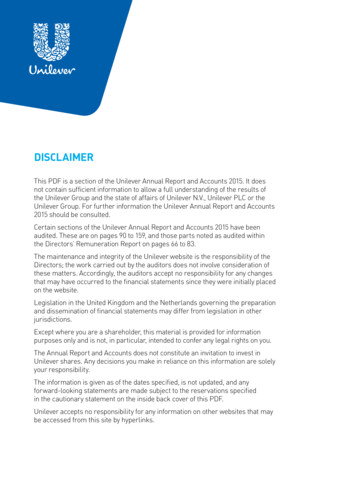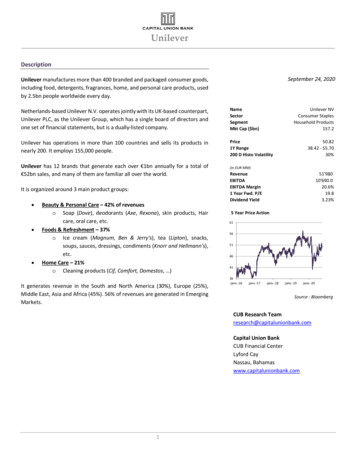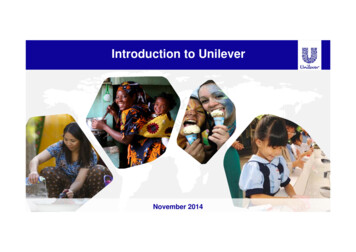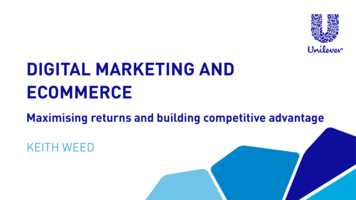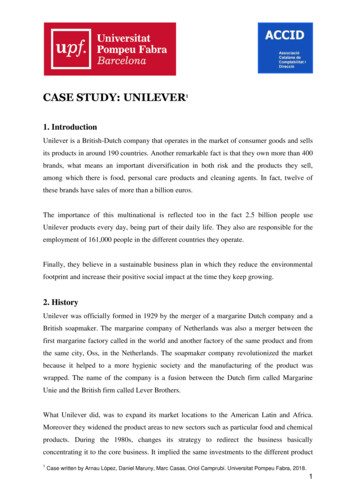
Transcription
CASE STUDY: UNILEVER11. IntroductionUnilever is a British-Dutch company that operates in the market of consumer goods and sellsits products in around 190 countries. Another remarkable fact is that they own more than 400brands, what means an important diversification in both risk and the products they sell,among which there is food, personal care products and cleaning agents. In fact, twelve ofthese brands have sales of more than a billion euros.The importance of this multinational is reflected too in the fact 2.5 billion people useUnilever products every day, being part of their daily life. They also are responsible for theemployment of 161,000 people in the different countries they operate.Finally, they believe in a sustainable business plan in which they reduce the environmentalfootprint and increase their positive social impact at the time they keep growing.2. HistoryUnilever was officially formed in 1929 by the merger of a margarine Dutch company and aBritish soapmaker. The margarine company of Netherlands was also a merger between thefirst margarine factory called in the world and another factory of the same product and fromthe same city, Oss, in the Netherlands. The soapmaker company revolutionized the marketbecause it helped to a more hygienic society and the manufacturing of the product waswrapped. The name of the company is a fusion between the Dutch firm called MargarineUnie and the British firm called Lever Brothers.What Unilever did, was to expand its market locations to the American Latin and Africa.Moreover they widened the product areas to new sectors such as particular food and chemicalproducts. During the 1980s, changes its strategy to redirect the business basicallyconcentrating it to the core business. It implied the same investments to the different product1Case written by Arnau López, Daniel Maruny, Marc Casas, Oriol Camprubí. Universitat Pompeu Fabra, 2018.1
areas of the business. During the 1990s, the company maintained the same policy direction inorder to have a more stable and consolidated market power. That is why the firm reducedabout 37 areas that they were competing to concentrate all the resources in 13 areas. The fourmore important were Food, Personal Care, Home Care and Speciality Chemicals.Initially at the 2000s, Unilever started adopting a social policy to promote sustainability inday-to-day activities and in the whole business.Unilever have been involved in multiple acquisitions during its history. In 1943, it becamethe major shareholder of Frosted Food, which also is the owner of Birds Eye and the rights inthe UK of freezing as a way to conserve the products, which was going to have a huge impactas a way to preserve foods in its natural form.It also acquires Good Humor in the US, an ice-cream factory; Zwanenber that later on will bethe basic unit of the meat sector of the firm.In 1971 it acquires Lipton International, a tea company increasing its market share andbecoming one of the biggest companies of the sector of tea. In 1973 it acquires Frigo, themain ice-cream company from Spain. in 1978, in order to have a bigger share in the US itacquires National Scratch, an organic chemical company. In 1984 the company did the firsthostile takeover, the company was Brooke Bond from the tea sector, the biggest seller fromthe United Kingdom with the help of a TV advertisement of two chimps. In 1986 it acquiresNaarden meaning a double of the market share of fragrances and food flavour. In the sameyear, the company acquires Chesebrough-Pond’s that was the owner of the Vaseline companyand Pond’s. In 1989, it acquired Calvin Klein and Elizabeth Arden/Fabergé both of cosmeticsbut later sold. In 1993 it acquired the ice-cream company from United States Breyers. In1996, it was acquired Helene Curtis in the hair sector. In 1997 ice-creams Kibon from Brazilis acquired. In 2000, it was acquired Bestfoods, considered the second acquisition with morecapital in history. There were also obtained Slim-Fast Foods, Ben & Jerry’s and the culinaryFrench firm Amora-Amille. It also acquired during 2007, local food leader in Russia anddrink brand from Indonesia called Buavita.Even though the acquisition that the company had been done since its merger, during the2000 century it began a process to reduced the number of brands that the company owned, in2001 it was reduced from 1,600 to 900 brands. In 2002 87 more brands were sold.In 2010, it increases the portfolio of brands of the firm by the acquisition of Alberto Culverthat owns TRESemmé among others.2
These would be the most important acquisitions of the company since its creation in 1929.Mid 1800sIn the Netherlands, the Jurgen and Van den Bergh families start thebutter-making business, later margarine.Late 1800sIn England, Lever & Co starts producing soap1890Lever is converted into a limited company, following a big expansion.1927The above-mentioned dutch families and other companies for theMargarine Union.1929Unilever if formed due to the merge of Margarine Union and LeverBrothers.1940sUnilever starts working in the frozen food industry1950sDevelopment of new mass markets for consumer goods (includes Africaand Asia).1954-55Launch of world-wide known personal care products such as Sunsilkshampoo or Dove.1971Acquisition of Lipton, the biggest tea business in the world.1973Acquisition of Frigo1983AXE is launched1985Launch of the first home use pregnancy test1986Expansion of the fragrances and food flavour industry.1986Acquisition of Pond, with its world-wide known brand Vaseline.1990sExpansion to eastern Europe2000Bestfoods joins Unilever, the second largest cash acquisition in history.Brands such as Knorr are included.2001Brand reform, from 1600 to 900 brandsFigure 1: Main events in the history of the company. Source: unilever.com3
3. Industry analysis and competitors3.1. Sales in every industry related to UnileverAs we will explain later, Unilever has 4 divisions which are Beauty & Personal Care, Foods& Refreshment, Home Care and Water Purifier. These sectors are in constant growth becauseof the constant population and demand. The only exception is the Water Purifier Industrywhich is growing very fast because of the popularity of the home water purifiers.Figure 2: Sales of the leading household/personal care companies worldwide in 2017 (in billion U.S. dollars).Source: statista.comAs we can observe in the Figure 2, the multinationals Unilever and Procter & Gamble areleading the Home Care and Personal care markets. It is important to mention that L’OréalGroup does not participate in the Home Care industry so we must highlight that the frenchcompany has a huge market share in the Beauty Industry.4
Figure 3: Leading beverage companies worldwide in 2017, based on sales (in million U.S. dollars). Source:Statista.comThe Beverage market is leaded by far by the world’s largest beer producer Anheuser-BuschInBev. They are followed by the huge rivals The Coca-Cola Company and PepsiCo Inc. Inthis market, Unilever has the potential to expand further on it because as we can see, Unileveris ranked as the eleventh beverage producer in terms of sales.5
Figure 4: The World’s Top 100 Food and Beverage Companies of 2015. Source:www.foodengineeringmag.comIn the Food industry, the swiss multinational Nestlé is leading with a huge market share.Unilever is placed eleventh and as we said in the Beverage market has still potential toexpand even though this Industry is very tough and competitive.The Global Water Purifier industry is currently valued at 10800 million US and is expectedto reach 15000 million US in 2025. This market is still very new so companies arepositioning themselves in the global market. Stand Out companies like Aquasana, Brita,PUR, Unilever Pureit and Philips.3.2 Main CompetitorsThe main competitors of Unilever are other Fast-Moving Consumer Goods (FMCG)companies with a similar structure and size. For example, the American consumer goodsmultinational Procter & Gamble, the largest food company in the world Nestlé, the BritishReckitt Benckiser Group which produces hygiene, health and home products, the globalmanufacturer Mars, the New York company Colgate-Palmolive, Johnson & Johnson theconsumer goods and pharmaceutical American multinational, the Kraft Heinz Company6
which is a recent merger and the german chemical and consumer goods Henkel. All of themwork internationally but try to understand consumers’ demands in every country they operate.3.3 Global FMCG companies total sales rankingFigure 5: Top 50 FMCG companies worldwide in 2017, based on net sales (in million U.S. dollars).Source:statista.comNowadays, Unilever is the fourth FMCG company based on their net sales of 2017 bymaking 60531 millions of U.S. dollars. The only companies that surpass Unilever in theFMCG market are Nestlé, Procter & Gamble and PepsiCo respectively. We must considerthat this ranking made by www.statista.com only contains the data of the companies that havepublished it. Companies like Oetker or Mars are not included.7
3.4 SWOT Analysis of the FMCG industryStrengthsEconomies of scale: Every FMCG company can take profit of economies of scale.No Seasonality: The FMCG Industry has constant sales because they produce products everyday products.Strong Brands: Presence of well known brands in this sector.WeaknessesDifferentiation in the FMCG market is difficult because producers can only compete inavailability, range of products and prices. Their products can be easily substituted, speciallyin emerging markets like Asia or Africa where they use traditional alternatives.Dependance of retailers: FMCG companies don’t usually sell their own products, so theydepend on retailers.Counterfeit consumer goods: Goods of inferior quality sold without the brand’s ownerauthorization under another’s name.High advertising costs: Increase in Advertising spending may affect margins.OpportunitiesImproving economic conditions: getting out of the recession leads to higher consume.Digital strategy: Going digital will lead to more sales for FMCG companies because peopleis increasingly buying online.Innovation: Products can be improved or invented in the healthcare market.International laws: The European Parliament and the European Commission are trying toprotect big food companies from some retail practices. The manager of Unilever Germanyhas publically supported it.Population Growth: Nowadays, population is constantly growing so the demand for FMCGgrows.ThreatsHighly competitive: Unilever competes with other huge companies like P&G and Nestlé andlocal companies that try to dominate every market.Retailer’s products: Increasing popularity in retailer’s own brands.Political situation: Non stable political situation in some emerging countries.8
4. Present situation of the company4.1. Products and services offeredThe products they sell can be classified in four divisions:-Beauty & Personal Care: Axe, Clear, Dove, Rexona.-Foods & Refreshment: Breyers, Cornetto, Heartbrand (Frigo), Hellmann’s, Knorr,Magnum, Ben&Jerry’s, Cornetto.-Home Care: Cif, Domestos, Comfort, Skip -Water Purifier: Unilever Pureit and TrulivaGROUP201720162015Turnover growth1.9%-1%10%Underlying sales growth3.1%3.7%4.1%Operating margin16.5%14.8%14.1%Free Cash Flow5.4 billion 4.8 billion 4.8 billion Figure 6: Group financial performance. Source: Unilever.comBY CATEGORIES201720162015Turnover20.7 billion 20.2 billion 20.1 billion Turnover growth2.6%0.5%13.2%Underlying sales growth2.9%4.2%4.1%Operating margin19.8%18.4%18.1%Turnover10.6 billion 10 billion 10.2 billion Turnover growth5.6%-1.5%10.9%PERSONAL CAREHOME CARE9
Underlying sales growth4.4%4.9%5.9%Operating margin10.8%9.5%7.3%Turnover12.5 billion 12.5 billion 12.9 billion Turnover growth-0.1%-3.1%4.5%Underlying sales growth1%2.1%1.5%Operating margin18.2%17.4%17.8%Turnover9.9 billion 10 billion 10.1 billion Turnover growth-0.8%-1.1%10.3%Underlying sales growth4.9%3.5%5.4%Operating margin13.5%9.7%8.3%FOODSREFRESHMENTFigure 7: Financial performance divided by categories. Source: Unilever.com10
Figure 8: Global revenue of the Unilever Group from 2005 to 2017, by product segment (in million euros).Source:statista.com,As we can observe in the previous graph, Unilever has increased their revenue over the past12 years in a 40%. The sectors that made possible this huge increase were the personal careindustry that doubled their revenue, the refreshment sector that expanded a 35% and thehome care industry that boosted a 50%. In the other hand, the food sector decreased an 8%,which is not a big deal compared to the gains in the other industries.It is relevant to underline that operating margin has improved in all sectors during the lastyears.4.2. Customers and Distribution Channels“We are committed to building trust through responsible practices and through transparentcommunication”. As Unilever explains in their website, they goal is to promote customers’loyalty so their image and their advertising is very important for them.Unilever’s Beauty & Personal Care, Home Care and Food brands sell their products insupermarkets and grocery stores. In the other hand, Truliva and Pure it sell their waterpurifiers online.11
4.3. Key success factorsFirstly, Unilever has more than 6000 scientists, engineers, chefs and technicians working inUnilever’s R&D trying to improve their products and inventing new ones.Another key factor is their diversification, they have a large range of product which allowsthem to reduce risks. Also, their investment in marketing and advertising is a key factor,Unilever won the award of the Most Awarded Advertiser at the 60th Cannes InternationalFestival of Creativity. In addition, Unilever’s CEO, Paul Polman, is very concerned about theclimate change and other social issues which give Unilever a fantastic image. Furthermore,he has received several awards and accolades for his responsible business and he is Chair ofthe International Chamber
CASE STUDY: UNILEVER 1 1. Introduction Unilever is a British-Dutch company that operates in the market of consumer goods and sells its products in around 190 countries. Another remarkable fact is that they own more than 400 brands, what means an important diversification in both risk and the products they sell, among which there is food, personal care products and cleaning agents. In fact .
